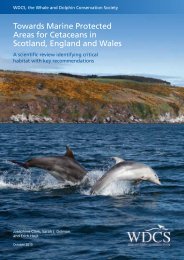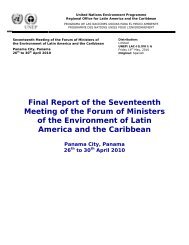Sea Turtle Recovery Action Plan for Barbados - WIDECAST
Sea Turtle Recovery Action Plan for Barbados - WIDECAST
Sea Turtle Recovery Action Plan for Barbados - WIDECAST
You also want an ePaper? Increase the reach of your titles
YUMPU automatically turns print PDFs into web optimized ePapers that Google loves.
CEP Technical Report No. 12<br />
beach was defined as one <strong>for</strong> which some sand remains exposed at even the highest tides. This<br />
figure exaggerates the number of beaches actually used by turtles <strong>for</strong> nesting, since it does not<br />
take into account the presence of housing developments nor the amount of vegetation on the<br />
beaches. However, because hawksbills do sometimes nest on highly public beaches, all beaches<br />
that were suitable as defined above were included in the assessment of the total amount of<br />
potential nesting beach available. On the west and south coasts, changes in beach width can be<br />
dramatic between nesting and hatching, although most nesting activity has ceased by the time the<br />
largest swells arrive.<br />
In<strong>for</strong>mation on nesting activity in 1987 was collected by two methods. First, as part of a<br />
national in<strong>for</strong>mation campaign, the public was asked to call a telephone number provided <strong>for</strong> the<br />
purpose of reporting observations (night or day) of turtle nesting or hatching activity. Second,<br />
volunteers from the <strong>Barbados</strong> Environmental Association conducted a series of early morning<br />
beach surveys during the peak breeding season (June-August) (section 4.291). Reports of<br />
hawksbill nesting came from most beaches along the west and south coasts of <strong>Barbados</strong>, as well<br />
as some sheltered east coast beaches (Map 4). Data combined from nesting reports and beach<br />
patrols indicated that 120-362 hawksbill nestings occurred (Horrocks et al., 1987; see also<br />
section 4.291). Gravid hawksbills in Antigua deposit up to six clutches of eggs per season<br />
(Corliss et al., 1989), but the modal (most common) number is five clutches (Jim Richardson,<br />
University of Georgia, pers. comm.). Based on an average of five nests per female, an estimated<br />
24-72 hawksbills nested in <strong>Barbados</strong> in 1987.<br />
Public awareness and participation in the monitoring of sea turtle nesting activity has<br />
increased substantially since 1987. In 1989, 1990, and 1991, the number of hawksbill nests<br />
reported by residents was 71, 60, and 91, respectively (Figure 3). Analysis of the timing and<br />
placement of these nests suggests that 37, 25, and 47 females nested in <strong>Barbados</strong> in 1989, 1990,<br />
and 1991, respectively (see also section 4.291). In addition to valuable input from residents, 1.5<br />
km of beach on the south coast from the <strong>Barbados</strong> Hilton east to Ocean View, where it was<br />
claimed that turtles nested in high numbers, was surveyed each morning throughout three<br />
consecutive nesting seasons (1989-1991) by a volunteer as part of the sea turtle conservation<br />
activities of Bellairs Research Institute. The results of this survey indicated there were 5-7<br />
hawksbills nesting annually on this stretch of beach. Assuming a remigration interval similar to<br />
Antigua (Corliss et al. 1990), an estimated total of only 15 individual females nested on this<br />
beach over the entire three year period. Although these numbers are small, in the context of the<br />
estimated size of the <strong>Barbados</strong> population, this area warrants protective measures.<br />
It is important <strong>for</strong> beach surveys to continue in order to further define essential habitat in<br />
<strong>Barbados</strong>, to monitor trends in nesting numbers, and to minimize threats to nesting turtles and<br />
their eggs. Systematic surveys should be initiated at beaches where hawksbills are known to nest<br />
and where the illegal killing of turtles is reported to occur; e.g., Long Beach on the south coast, a<br />
strip of beach between Heywoods and Six Mens on the northwest coast, and Bath on the east<br />
coast. Early morning surveys could be conducted by volunteers, but this would require<br />
collaboration between several organisations, including Bellairs Research Institute, <strong>Barbados</strong><br />
Environmental Association, <strong>Barbados</strong> National Trust, the secondary schools, etc. Bellairs<br />
Research Institute (Lead Organisation <strong>for</strong> <strong>WIDECAST</strong> in <strong>Barbados</strong>) or <strong>Barbados</strong> Environmental<br />
Association could co-ordinate activities and provide training <strong>for</strong> volunteers. Alternatively, inter-<br />
Page 12

















